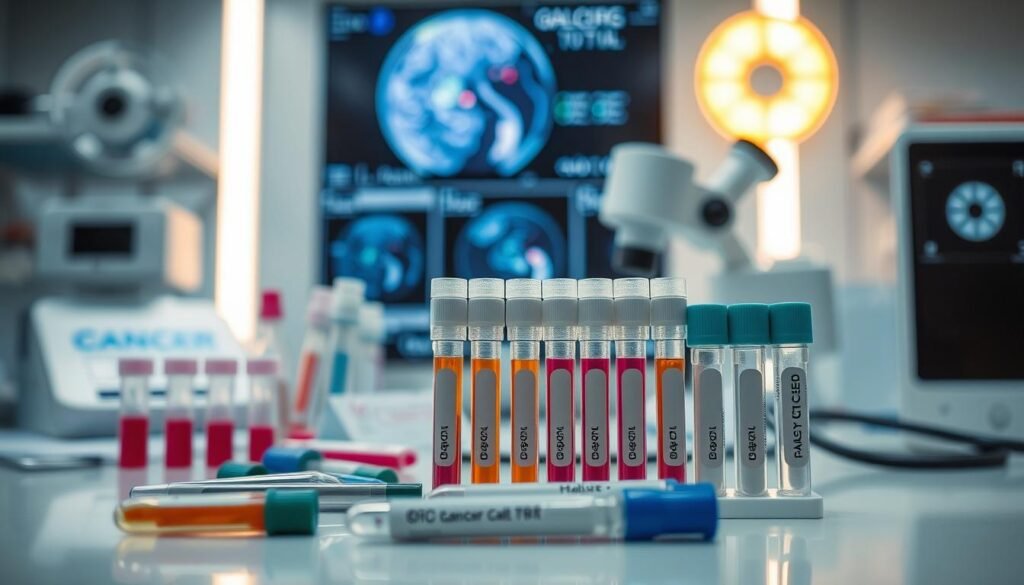Did you know? The five-year survival rate for Stage 1 breast cancer is an amazing 99%. This shows how key early detection is. It leads to hopeful outcomes for those diagnosed with cancer. Stage 1 cancer means the tumor has not spread from where it started.
This makes knowing about early stage life expectancy and treatments so important. This article will cover what Stage 1 cancer is, its prognosis, and treatment paths. You’ll learn about the survival rates and get tips for handling this tough time. For deeper details, check this link on stage 1 cancer.
Key Takeaways
- Stage 1 cancer is usually localized, leading to high survival chances.
- The 5-year relative survival rate for localized Stage 1 breast cancer is 99%.
- Finding cancer early is crucial for a better prognosis.
- Treatment often involves surgery and additional therapies.
- KUnderstanding cancer stages aids in making treatment choices.
- Continual support and care can improve life after treatment.
- Joining clinical trials might offer new treatment options.
Understanding Stage 1 Cancer
Stage 1 cancer is the first step in a classification that shows how much cancer is in the body. Knowing about stage 1 cancer helps to choose treatments and know what to expect. This stage means the cancer is still small and localized. It has not spread to lymph nodes or other parts of the body.
Definition of Stage 1 Cancer
For cancer staging, stage 1 is when tumors are still in one area, usually up to a certain size. For example, stage 1 breast cancer may have a tumor up to 2 cm big. It may spread a little but stays in one place. This helps doctors create the right treatment plans and predict how well a patient might do.
Characteristics of Stage 1 Cancer
Characteristics of stage 1 cancer show what makes it different from other stages. Tumors are usually small, under 2 cm. They haven’t spread to nearby lymph nodes. This makes the chances of successful treatment better. Finding it early means better chances for patients. For more on cancer stages, click here.
Early Stage Life Expectancy
Early detection of cancer leads to higher optimism in prognosis. Survival rates for different cancers show this benefit clearly. For instance, detecting breast cancer early can nearly guarantee survival for five years.
General Survival Rates for Early Stage Cancers
Early-stage cancers like Stage I and II have significantly better survival rates. For example, localized breast cancer has an almost 100% five-year survival rate. But Stage III cancers see survival rates drop to 66%-98%. Early detection means better outcomes.
Factors Influencing Life Expectancy
Many factors affect cancer patients’ life expectancy. Age at diagnosis and overall health status are crucial. Genetic factors also play a role in treatment response. It’s important to understand these factors for personal treatment plans.
Detailed information on survival rates is available at Cancer Research UK. This resource offers in-depth insights into prognostic factors.
Stage 1: Early Stage Life Expectancy
Stage 1 cancer has a good outlook, especially for cancers like breast cancer. People diagnosed at this stage with breast cancer have high survival rates. Knowing these rates helps us understand life expectancy and how to treat the cancer.
Specific Survival Rates for Breast Cancer
Women with stage 1 breast cancer have a 5-year survival rate of about 99%. This amazing rate shows the importance of finding cancer early. Early screenings play a big role in improving chances of survival.
Comparative Life Expectancy for Other Stage 1 Cancers
The survival rates for different types of stage 1 cancer vary. For example, stage 1 non-small cell lung cancer (NSCLC) patients have a 5-year survival rate between 70% to 92%. This depends on the tumor size and other factors. Lung cancer can come in different types:
| Lung Cancer Stage | Size | 5-Year Survival Rate |
|---|---|---|
| Stage 1A1 | 1½ inches or less | 92% |
| Stage 1A2 | Between 1½ and 2 inches | 83% |
| Stage 1A3 | Between 2 and 3 inches | 77% |
| Stage 1B | Between 3 and 5 cm | 68% |
Patients with stage 1 pleural mesothelioma live about 21 months on average. Different treatments can help extend their lives. These facts show how crucial early detection is, no matter the type of cancer.

Diagnosing Stage 1 Cancer
Detecting Stage 1 cancer focuses on several key tests. These are vital in spotting cancer early, which helps shape the treatment path. Catching cancer early drastically improves the chances of beating it.
Common Diagnostic Tests
Doctors use different imaging and biopsy techniques depending on the cancer type. For example:
- Mammograms pinpoint potential breast cancer areas early.
- Ultrasounds let doctors see soft tissues as they work.
- Biopsies remove tissue for close examination under a microscope, confirming if cancer is present.
The tests chosen depend on the cancer being checked for. But finding and diagnosing cancer accurately and quickly is always the goal. You can learn more about cancer diagnostics here.
Importance of Early Detection
Finding cancer in Stage 1 can greatly improve treatment success. Routine screenings help catch cancers early, often leading to a better outlook. For instance, nearly all women with Stage 1 breast cancer in England live at least five years post-diagnosis.
Early detection also means more and often less harsh treatment options. It makes a significant difference in recovery. Keeping up with health check-ups is crucial in fighting cancer effectively.

| Type of Cancer | Five-Year Survival Rate | Stage |
|---|---|---|
| Breast Cancer | Almost 100% | Stage 1 |
| Pancreatic Cancer | 44% | Localized |
| Ovarian Cancer | Varies by stage | Stage I to IV |
Treatment Options for Stage 1 Cancer
Treatment for stage 1 cancer often includes surgery. This is crucial for handling many cancer types. Options like lumpectomy and mastectomy are common, especially for breast cancer. Most people choose lumpectomy because it saves more of the breast. Adjuvant therapies also help lower the chance of cancer coming back.
Surgical Choices and Procedures
Lumpectomy targets the tumor and a bit of nearby tissue. Mastectomy, however, means removing one or both breasts. Choosing between these depends on tumor size, location, and patient health. Techniques like sentinel lymph node biopsy check if cancer has reached nearby lymph nodes.
Adjuvant Therapy Options
After surgery, additional treatments can improve results. For example, hormone therapy is advised for certain breast cancer cases. Chemotherapy might follow surgery, particularly for larger tumors. In stage 1 non–small cell lung cancer, options include cisplatin and vinorelbine. Treatments like Atezolizumab are considered if there’s a risk of the cancer returning.

Combining surgery with specific adjuvant therapies shapes a complete treatment plan. This is tailored to each patient’s needs and cancer type. Having access to skilled oncologists is essential. They help decide the best treatment path. For more details on leading lung cancer oncologists, click here.
| Procedure Type | Description | Common Usage |
|---|---|---|
| Lumpectomy | Removal of the tumor and a small margin of breast tissue. | Early stage breast cancer, patient preference for breast conservation. |
| Mastectomy | Complete removal of one or both breasts. | Large tumors or patient preference for complete removal. |
| Chemotherapy | Use of drugs to eliminate cancer cells. | Post-surgery for larger tumors or high recurrence risk. |
| Adjuvant Therapy | Additional treatments following surgery to prevent recurrence. | Hormone receptor-positive tumors, stage 1 non–small cell lung cancer. |
Factors Impacting Treatment Outcomes
Understanding what affects treatment results is key in fighting cancer effectively. How well and how old a patient is greatly influences how they react to treatment. Age affects the kinds of treatments that can be used and how well the body handles them. The choice of additional treatments is also shaped by these patient details and the disease’s own traits.
Patient Health and Age
The average age of those getting treatment is 67, with ages ranging from 36 to 91. This age range plays a big role in how successful treatment might be. Older patients, for example, often face more health issues besides cancer, which can change how well they recover. Studies show that as patients get older, their chances of surviving cancer can decrease.
Out of the data, 63% received a variety of treatments while 37% did not have extra therapy. This shows how health can influence treatment options.
Cancer Type and Characteristics
The kind of cancer and its features greatly affect treatment success. Important factors include the cancer’s stage, grade, and specific biological markers. The data showed most had stage IA cancer (67%) but outcomes varied with stage IB (21%) and stage II (11%). A rhabdomyosarcoma component adds a higher risk, impacting survival chances.
Tumor size and whether lymph nodes are affected also matter a lot for prognosis. Smaller tumors without lymph node issues often lead to better survival odds than bigger, multifocal tumors. Understanding these aspects is vital for tailor-made treatment plans that aim to get better results.
| Factor | Impact on Treatment Outcomes |
|---|---|
| Age | Older patients may have worse survival rates due to comorbidities and treatment tolerance. |
| Cancer Stage | Higher stages correlate with elevated risk of recurrence and lower overall survival. |
| Tumor Size | Smaller tumors typically offer a more favorable prognosis compared to larger ones. |
| Biological Markers | Hormone receptor status significantly influences short-term prognosis outcomes. |
Clinical Trials and Their Importance
Clinical trials play a huge role in advancing cancer treatment options. They allow Stage 1 cancer patients to try new treatments not widely available. By joining these trials, individuals can use new therapies that may boost their health. At the same time, they contribute to important research.
Access to New Treatments
With around 800 cancer drugs under development, clinical trials are vital. They offer patients early access to revolutionary treatments, sometimes 10 years before the FDA approves them. Response rates in early-stage trials have increased notably over time.
In the past, response rates were under 5% in the 1970s and 1980s. Now, they’re nearly 20%, with some genomic-focused trials hitting 42%.
How to Participate in Clinical Trials
Those interested in joining trials should talk to their doctors about eligibility. Most trials ask for patients to have an expected lifespan of at least three months. Being part of a trial gives access to the latest treatments. It also supports the creation of new, effective cancer therapies.
This collective effort is crucial for making significant advances in cancer treatment.
Palliative Care in Stage 1 Cancer
Palliative care in cancer treatment is essential for patients with Stage 1 cancer. It improves their quality of life. This care helps ease symptoms and supports patients and families emotionally and psychologically. It is useful at any stage of the cancer journey, starting from diagnosis to treatment.
The Role of Palliative Care
Palliative care includes pain management, nutritional support, and counseling. These improve patient satisfaction and reduce distress. Early palliative care can enhance life quality and mood for patients. It might also extend patients’ lives when used with standard treatments.
Benefits of Supportive Care
Supportive care offers many benefits, especially for those with advanced cancer. It tackles issues like dyspnea, pain, nausea, and fatigue. Early palliative care aims to improve life quality, lessen anxiety and depression, and align with patient preferences. Patients have reported better sleep quality and less distress.
Using palliative care with traditional treatment can reduce hospital and emergency room visits. This ensures patients get the best care throughout their journey. The American Society of Clinical Oncology emphasizes its importance. For more on treatment options like radiation, check guides on radiation therapy for lung cancer.
| Aspect | Palliative Care | Standard Care |
|---|---|---|
| Symptom Management | Comprehensive, holistic approach | Treatment-focused, may overlook holistic needs |
| Patient Satisfaction | Higher satisfaction rates reported | Varies, often lower satisfaction |
| Hospitalization | Reduced hospital visits | Higher frequency of hospitalizations |
| Mood Improvement | Significant enhancement | Limited focus on psychological support |
| Quality of Life | Substantial improvement | Variable based on treatment efficacy |
Conclusion
Understanding stage 1 cancer is very important for patients and their families. A quick diagnosis and treatment can make a big difference. For example, people with stage 1 breast cancer have a 99% chance of living for at least five years.
This is because of good treatment options like surgery and chemotherapy. Plus, a 91% survival rate for all SEER stages shows how crucial early treatment is.
There are many ways to treat cancer, including treatments that target the whole body. Knowing the risk factors and living well can also help. This shows a bright side of cancer care, where new methods and smart patient steps lead to a better life.
Research is getting better all the time, making regular checks even more important. Being educated about stage 1 cancer brings hope. By understanding their high chances and choosing the right treatment, patients can face cancer with strength and hope.